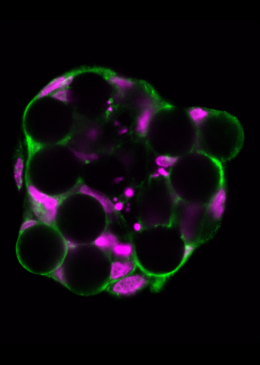ASSIGNMENT STARTS ON 1 JULY
Microgels as Artificial Cells
AIM
Design and optimize microgels with cell-like properties to advance 3D cell culture studies.
INTRODUCTION
Culturing cells in aggregates is a very efficient approach to study their interactions in a natural 3D environment. However, complete understanding of cell-cell interactions in cellular co-cultures has not yet been achieved. We hypothesize that artificial cells made from small hydrogel beads (i.e., microgels) could play a significant role in gaining deeper understanding of cellular interactions. Specifically, we aim to engineer microgels with the size and certain functions of natural cells. Custom modifications of these artificial cells would enables the controlled study of specific interactions within 3D cell aggregates.
Recently, our group has developed a microfluidic platform for the production of cell adhesive microgels that can be incorporated in cell aggregates.[1] We have demonstrated that these cell/gel microcultures can be cultured for several days to weeks. Furthermore, the microgels can be endowed with biofunctional moieties, indeed providing them with cell-like functions and thus acting as artificial cells.
 In this project, the student will design and investigate various artificial cells. For example, microgels will be functionalized with cell-adhesive moieties, cell-cell adhesion mimicking peptides, and growth factor binding compounds. The artificial cells will be combined with natural cells in 3D co-cultures. Specifically, the effect of artificial cells that bind specific growth factors on stem cell differentiation will be studied.
In this project, the student will design and investigate various artificial cells. For example, microgels will be functionalized with cell-adhesive moieties, cell-cell adhesion mimicking peptides, and growth factor binding compounds. The artificial cells will be combined with natural cells in 3D co-cultures. Specifically, the effect of artificial cells that bind specific growth factors on stem cell differentiation will be studied.
3D microaggregate of cells and microgels.[1]
GOALS
- Produce cell-sized microgels using droplet microfluidics
- Functionalize microgels with biofunctional moieties
- Combine artificial cells with natural cells in 3D co-cultures
- Steer differentiation of stem cells using growth factor binding artificial cells
TECHNIQUES
The student will learn several state-of-the art techniques, including droplet microfluidics, enzymatic hydrogel crosslinking, (3D) stem cell culture, immunohistochemistry, and confocal fluorescence imaging and apply this skill set in a top-level institute to perform pioneering work on artificial cells.
REFERENCES
1. Kamperman, T., Microgel Technology to Advance Modular Tissue Engineering, in
Developmental BioEngineering. 2018, University of Twente. p. 174.
